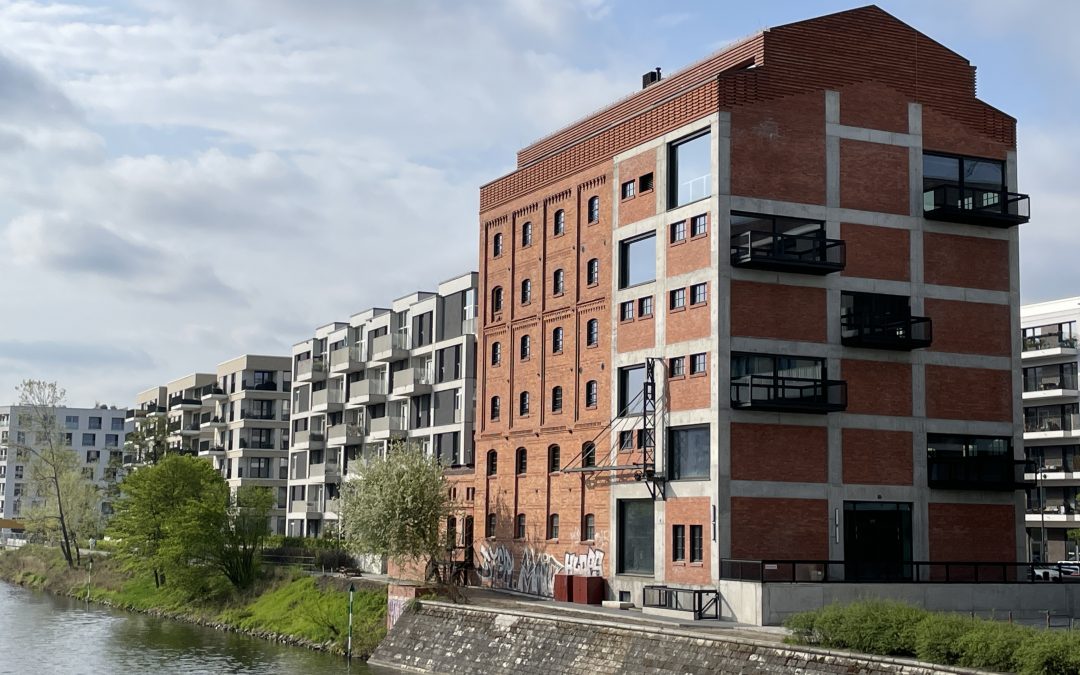Copyright: Taurecon GmbH
- Space for modern working environments, culture and gastronomy in Europacity
- 7 levels with approx. 2,371 sqm of usable space
- Visible from afar at the Berlin-Spandau shipping canal
The return of Europacity’s historic landmark
Berlin’s Europacity got its historic landmark back: the striking brick building of the 1897 Kornversuchsspeicher at the Berlin-Spandau shipping canal shines in new splendour, visible from afar. The highly unusual building with its three components is part of Wasserstadt Mitte, a new residential quarter realised by Adler Group with over 500 residential units on the waterfront. The conversion and refurbishment of Kornversuchsspeicher was carried out according to plans by AFF Architekten, specialists for historic buildings and multiple award winners. Taurecon realised the project in cooperation with Heide Siegmund-Schultze for the Adler Group. Even before construction began, several exhibitions and events supported an interim artistic use of the old warehouse.
Taurecon is also responsible for the development of the neighbouring Quartier Heidestrasse to the west, with almost 200,000 sqm of office and commercial space and over 940 rental flats.
Responsible refurbishment for a variety of uses
Progressive open office spaces have been created on the upper floors of the now completed building, suitable for co-working as well as creative start-ups or modern office tenants. Clinker fields of the northern part of the building were partially replaced by large-format windows and several balconies with a view towards Nordhafen were hung in front, as a sign of the conversion from a closed warehouse building to an open location that can be used for a variety of purposes.
The ground floor was developed as an exhibition and event location with a possible connected café and large terrace, and with the addition of a monochrome roof storey with a clinker brick façade and large-scale, sliding glass elements, a further 210 sqm on both sides with large roof terraces are available for flexible uses including gastronomy. The listed building was redesigned and made barrier-free accordingly to meet the different requirements of future users.
“Kornversuchsspeicher is the only historic building in the northern Europacity that survived the war and, with its imposing seven-storey presence directly on the canal, is undoubtedly a real landmark,” says Thomas Bergander, founder and managing director of Taurecon. “It was clear to us from the outset that such a building and the history behind it had to be handled responsibly.”
Tangible urban history
In addition to the construction of the additional level, the structural reinforcement of this early reinforced concrete building was very complex, as the building fabric had been severely damaged by years of vacancy. A comprehensive reinforced concrete renovation of the columns, ceilings and historic chutes was carried out. Two ceilings were demolished, and new steel galleries were installed to create usable floor heights. The clinker brick façades were completed in small and large areas. Stones removed for new window openings were cleaned and reused. Inside, the distinctive grain shacks of the ceilings remained visible, as did joists, rough historic concrete surfaces, demolition edges and steel details. The architectural concept involved exposing or preserving the historical elements of this robust industrial building and consistently adding to them in a modern, high-quality way. In this way, the fundamental form of the grain test silo is preserved and can be experienced as an important piece of the city’s history, even for future generations when it is used again.
The building’s original purpose is closely linked to Berlin’s path to becoming a metropolis: After the city’s population had increased almost tenfold in less than 100 years, new ways had to be found at the end of the 19th century to ensure that the inhabitants were fed. This led to the construction of the grain test store as a metropolitan laboratory and test centre for new methods of food storage. “If young, creative start-ups now find solutions to contemporary problems here in the future, that seems quite fitting to me,” explains Tomas Bergander.

